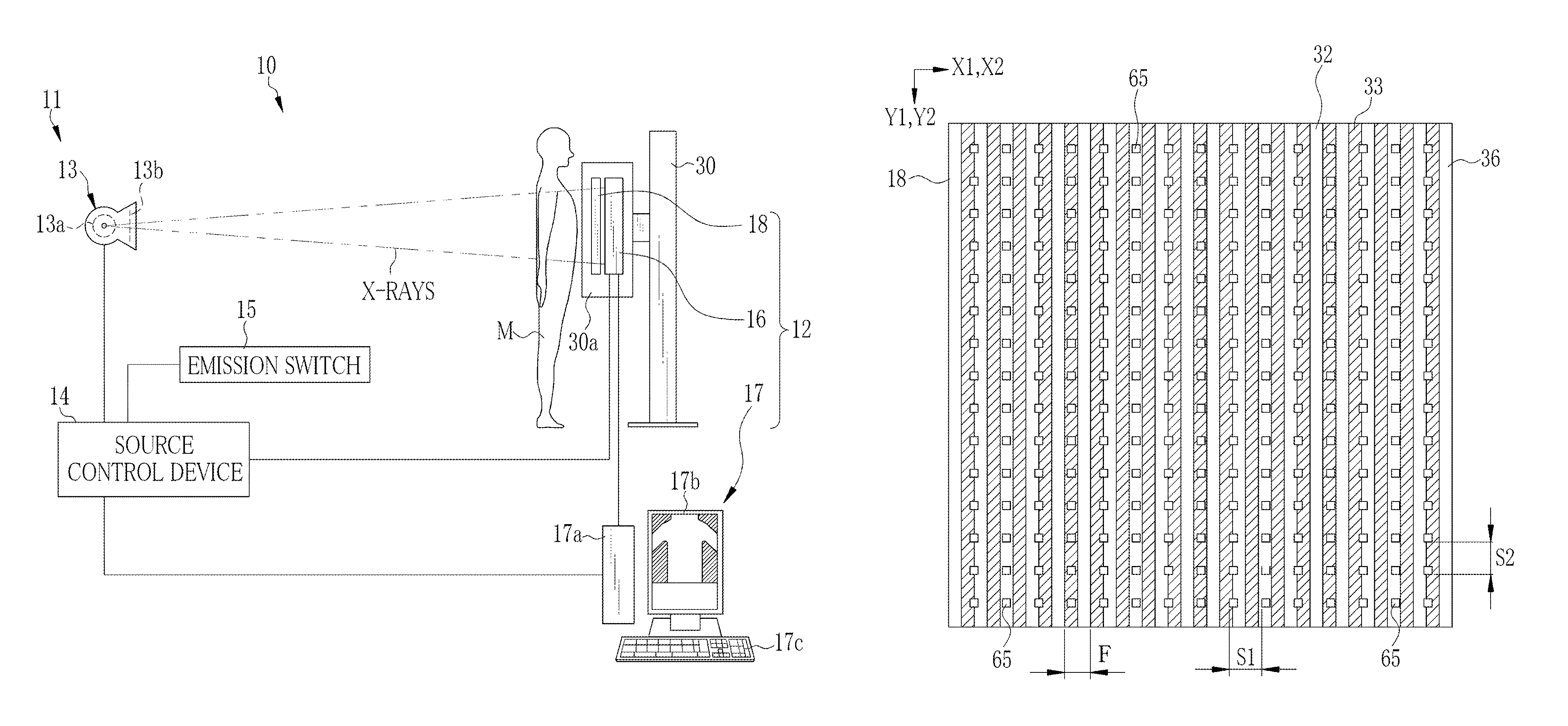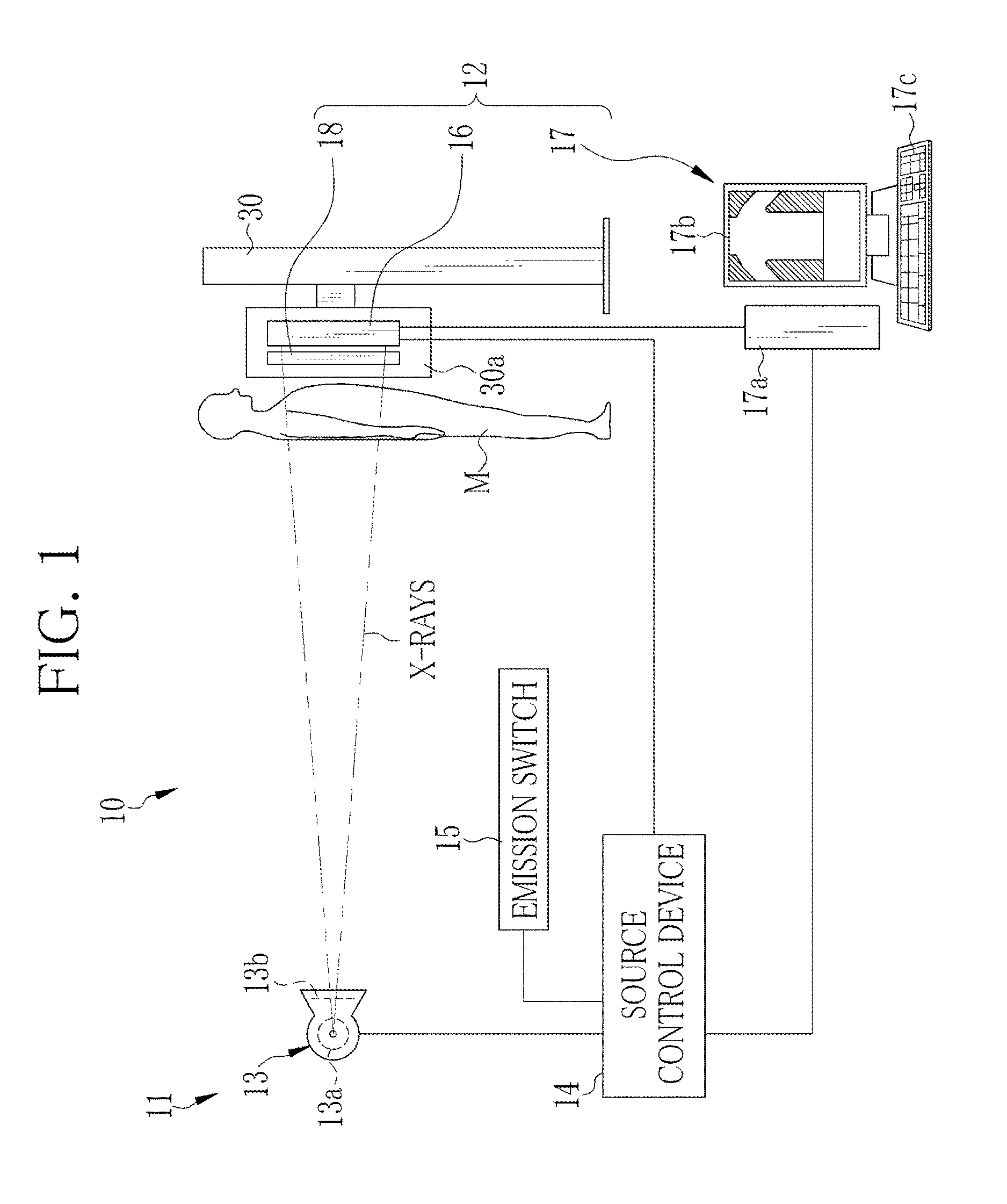Radiation image detecting device and radiation imaging system
a radiation image and detection device technology, applied in the field of radiation image detection devices and radiation imaging systems, can solve the problems of reducing the image quality of the x-ray image, requiring time and effort to obtain the gain image, and causing the image quality to be degraded. , to achieve the effect of reducing the fear of image quality degradation and requiring no time and effor
- Summary
- Abstract
- Description
- Claims
- Application Information
AI Technical Summary
Benefits of technology
Problems solved by technology
Method used
Image
Examples
first embodiment
[0059]As shown in FIG. 1, an X-ray imaging system 10 according to the present invention is constituted of an X-ray generating device 11 for generating X-rays and an X-ray imaging device 12 for taking an X-ray image from the X-rays passed through a patient M, being an object. The X-ray generating device 11 includes an X-ray source 13 for emitting the X-rays, a source control device 14 for controlling the X-ray source 13, and an emission switch 15 for commanding the start of X-ray emission. The X-ray imaging device 12 includes an electronic cassette 16 being a portable X-ray image detecting device, a console 17 for controlling the electronic cassette 16, and an imaging stand 30. The source control device 14, the electronic cassette 16, and the console 17 are connected wiredly or wirelessly so as to be communicated with each other. An upright type imaging stand is used as the imaging stand 30 in this embodiment, but a bed type imaging stand may be used instead.
[0060]The electronic cass...
second embodiment
[0137]In a second embodiment shown in FIGS. 18 and 19, each of the arrangement period S1 and the arrangement period F is represented as a length in unit of the number of the pixels 45. In FIG. 18, the arrangement period S1 is 7 because there is space of six pixels 45 between the two detection pixels 65. The arrangement period F has a length of four pixels 45, so a conversion value, being the number of pixels 45 into which the arrangement period F is converted, is 4. In an example shown in FIG. 19, the arrangement period S1 is 6, and the arrangement period F is 4.
[0138]Both of FIGS. 18 and 19 satisfy the relation of arrangement period S1≠the arrangement period F, and hence represent embodiments included in the present invention. However, comparing between FIGS. 18 and 19, an example of FIG. 18 is more preferable. The reason is as follows. In the example of FIG. 18, since the arrangement period S1 of the detection pixels 65 is 7 and the arrangement period F is 4, the arrangement perio...
third embodiment
[0144]In a third embodiment shown in FIGS. 20 to 22, an array of the detection pixels 65 in which the average of the dose detection signals of the detection pixels 65 is calculated is grouped into one set 200. The sets 200 are periodically arranged in the same or different rows, so as to arrange the sets 200 over the entire imaging surface 36 in a distributed manner. The set 200 is a minimum unit of a group of the detection pixels 65 in which the AEC section 67 calculates the average of the dose detection signals. Note that, the sets 200 may be arranged intensively in a region corresponding to the measurement area set in advance, such as left and right lung fields, for example, instead of being arranged over the entire imaging surface 36.
[0145]A set 200a shown in FIG. 20A is an example in which a plurality of detection pixels 65 (four detection pixels 65 in this example) is arrayed in one row extending in the X2 direction at an arrangement period S1=5, and the sets 200a are regularl...
PUM
 Login to View More
Login to View More Abstract
Description
Claims
Application Information
 Login to View More
Login to View More - R&D
- Intellectual Property
- Life Sciences
- Materials
- Tech Scout
- Unparalleled Data Quality
- Higher Quality Content
- 60% Fewer Hallucinations
Browse by: Latest US Patents, China's latest patents, Technical Efficacy Thesaurus, Application Domain, Technology Topic, Popular Technical Reports.
© 2025 PatSnap. All rights reserved.Legal|Privacy policy|Modern Slavery Act Transparency Statement|Sitemap|About US| Contact US: help@patsnap.com



